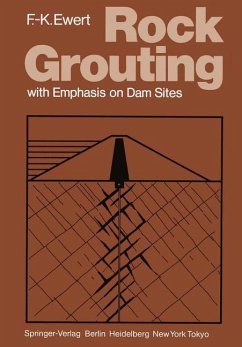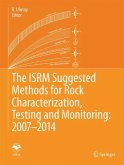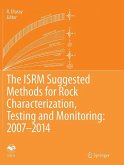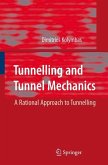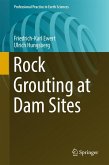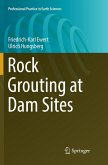- Broschiertes Buch
- Merkliste
- Auf die Merkliste
- Bewerten Bewerten
- Teilen
- Produkt teilen
- Produkterinnerung
- Produkterinnerung
Fifteen years have passed since I was working at a dam site super vising grouting work. That was not the first time that I had to car ry out engineering geological investigations for several similar projects, which always included testing programmes to find out the permeability of the rock, and often I was in charge of grouting work. It thus attracted my attention when this particular grouting programme did not run as intended: most of the grout holes took only very little grout! It could not be the aim of the invested work simply to drill holes and fill them again without bringing about any…mehr
Andere Kunden interessierten sich auch für
![Rock Mechanics Rock Mechanics]() Walter WittkeRock Mechanics150,99 €
Walter WittkeRock Mechanics150,99 €![The ISRM Suggested Methods for Rock Characterization, Testing and Monitoring: 2007-2014 The ISRM Suggested Methods for Rock Characterization, Testing and Monitoring: 2007-2014]() The ISRM Suggested Methods for Rock Characterization, Testing and Monitoring: 2007-2014165,99 €
The ISRM Suggested Methods for Rock Characterization, Testing and Monitoring: 2007-2014165,99 €![The ISRM Suggested Methods for Rock Characterization, Testing and Monitoring: 2007-2014 The ISRM Suggested Methods for Rock Characterization, Testing and Monitoring: 2007-2014]() The ISRM Suggested Methods for Rock Characterization, Testing and Monitoring: 2007-2014164,99 €
The ISRM Suggested Methods for Rock Characterization, Testing and Monitoring: 2007-2014164,99 €![Tunnelling and Tunnel Mechanics Tunnelling and Tunnel Mechanics]() Dimitrios KolymbasTunnelling and Tunnel Mechanics112,99 €
Dimitrios KolymbasTunnelling and Tunnel Mechanics112,99 €![Rock Grouting at Dam Sites Rock Grouting at Dam Sites]() Friedrich-Karl EwertRock Grouting at Dam Sites112,99 €
Friedrich-Karl EwertRock Grouting at Dam Sites112,99 €![Rock Grouting at Dam Sites Rock Grouting at Dam Sites]() Friedrich-Karl EwertRock Grouting at Dam Sites75,99 €
Friedrich-Karl EwertRock Grouting at Dam Sites75,99 €![Geotechnical and Geoenvironmental Engineering Handbook Geotechnical and Geoenvironmental Engineering Handbook]() Geotechnical and Geoenvironmental Engineering Handbook40,99 €
Geotechnical and Geoenvironmental Engineering Handbook40,99 €-
-
-
Fifteen years have passed since I was working at a dam site super vising grouting work. That was not the first time that I had to car ry out engineering geological investigations for several similar projects, which always included testing programmes to find out the permeability of the rock, and often I was in charge of grouting work. It thus attracted my attention when this particular grouting programme did not run as intended: most of the grout holes took only very little grout! It could not be the aim of the invested work simply to drill holes and fill them again without bringing about any further improvement. Fortunately, I had the chance to be en gaged in many other grouting programmes in the following years and used all these examples to analyse as thoroughly as possible the permeability of the rocks being treated in view of their grout ability. The more I studied, the stronger my conviction grew that our rules which had decided the grouting of rock for many de cades should be developed further, and therefore I occupied my self with contributing some ideas for a new basis to investigation and judgment of permeability of rock and for a more adequate application of this technology.
Produktdetails
- Produktdetails
- Verlag: Springer / Springer Berlin Heidelberg / Springer, Berlin
- Artikelnr. des Verlages: 978-3-642-51013-7
- Softcover reprint of the original 1st ed. 1985
- Seitenzahl: 444
- Erscheinungstermin: 27. Juni 2012
- Englisch
- Abmessung: 244mm x 170mm x 24mm
- Gewicht: 760g
- ISBN-13: 9783642510137
- ISBN-10: 3642510132
- Artikelnr.: 37479400
- Herstellerkennzeichnung
- Springer-Verlag GmbH
- Tiergartenstr. 17
- 69121 Heidelberg
- ProductSafety@springernature.com
- Verlag: Springer / Springer Berlin Heidelberg / Springer, Berlin
- Artikelnr. des Verlages: 978-3-642-51013-7
- Softcover reprint of the original 1st ed. 1985
- Seitenzahl: 444
- Erscheinungstermin: 27. Juni 2012
- Englisch
- Abmessung: 244mm x 170mm x 24mm
- Gewicht: 760g
- ISBN-13: 9783642510137
- ISBN-10: 3642510132
- Artikelnr.: 37479400
- Herstellerkennzeichnung
- Springer-Verlag GmbH
- Tiergartenstr. 17
- 69121 Heidelberg
- ProductSafety@springernature.com
1 Introduction.- 2 Remarks on the Methodology of Preparation.- 3 Analysis of Completed Grouting Programmes.- 3.1 Preliminary Remarks.- 3.2 Description and Evaluation of the Programmes.- 3.3 Microscopical Studies.- 3.4 Generally Valid Conclusions from the Analysis of the Grouting Programmes.- 4 Discussion of the Conventional Investigation Methods for Determining Rock Permeability.- 4.1 Introduction.- 4.2 On the Execution, Evaluation and Interpretation of Water Pressure Tests.- 4.3 Assessment of Current Investigation Methods for Rock Permeability.- 4.4 Conclusions.- 5 On Hydraulic Routing in Rock.- 5.1 Introduction.- 5.2 Methods of Researching the Hydraulic Routing in Rock.- 5.3 Influential Factors in the Development of Water Paths in Rock.- 5.4 Discontinuities as Prescribed Water Paths and Their Behaviour During Grouting.- 5.5 The Results of Field Investigations of the Hydraulic Routing.- 5.6 Synopsis of the Percolation Behaviour in Rock.- 5.7 Remarks on Percolation Models and Calculation Methods in Rock Mechanics.- 6 Studies of the Relationship Between the Type of Hydraulic Routing, the Course of the Water Pressure Tests and Grouting Behaviour.- 6.1 Introduction.- 6.2 Tests Using Geologically Defined Models for the Hydraulic Routes Around the Boreholes.- 6.3 Interpretation of Simulated Water Pressure Tests and Conclusions.- 6.4 Interpretation of Simulated Grouting Tests and Conclusions.- 7 Practical Field Investigations on Permeability by Means of Water Pressure Tests.- 7.1 Introduction.- 7.2 Rock Fracturing Contingent upon Injection Pressure.- 7.3 Appropriate Maximum Pressures for Water Pressure Tests.- 7.4 The Factor "Time" in Conducting the Water Pressure Tests.- 7.5 Characteristic Water Pressure Tests for Determining the Permeability Behaviour of Different RockTypes.- 7.6 Comparison of Rock Permeabilities Under the Conditions of Injection and Operation.- 7.7 Water Pressure Tests in Grouted Rocks for Controlling its Success.- 7.8 On the Definition of "Reference" Pressure.- 8 Practical Criteria for Determining Grouting Methods Considering Rock-Type-Specific Groutability.- 8.1 Introduction.- 8.2 Selection of Grouting Pressures in View of the Fracturing Behaviour.- 8.3 Assessing the Rock-Type-Specific Groutability.- 8.4 Penetration or Displacement Grouting?.- 8.5 Comments on Setting W/C Ratios.- 8.6 Spacing of Grout Holes, Grouting in Series.- 8.7 Downstage or Upstage Grouting, Schematic or Adapted Execution, Accompanying Water Pressure Tests.- 8.8 Relationship Between the Type of Hydraulic Routing and the Remaining Permeability.- 8.9 Test Grouting.- 9 Practical Criteria for Determining the Tolerable Permeability.- 9.1 Introduction, Hydraulic Fundamentals, Depth of the Curtain, "Tolerable Permeability".- 9.2 Estimating the Mean Permeability of the Rock for Determining Seepage Losses.- 9.3 Erodibility.- 9.4 Examples of the Possible Differences Between Groutable and Tolerable Permeabilities.- 9.5 Changes in Permeability and Groutability Due to Comparatively High Storage Levels.- 9.6 The Expenditures for Grouting Programmes Compared with the Degree of Impermeabilization.- 9.7 Summarizing Assessment of the Tolerable Permeability.- 9.8 The Expediency of a Control Gallery Considering Geological Setting and Rock-Type-Specific Groutability.- 9.9 Lateral Extension of the Grout Curtain, Systematic Groundwater Measurements Prior to the Construction of the Dam.- 9.10 Influence of the Type of the Project on the Tolerable Permeability.- 10 The Influence of the Local Geological Setting and the Grouting Measures on the Reduction ofUplift.- 10.1 Introduction.- 10.2 Example: Aabach Dam.- 10.3 Example: Antrift Dam.- 10.4 Example: Tavera Dam.- 10.5 Example: Twiste Dam.- 10.6 Conclusions Concerning the Reduction of the Uplift.- 11 Final Remarks: an Attempt at Guide-Lines.- 11.1 Hydrogeological Scope.- 11.2 Site Investigations by Geological Mapping, Core Drilling, Testing of Both Permeability and Groutability.- 11.3 Control Measures During Impoundment.
1 Introduction.- 2 Remarks on the Methodology of Preparation.- 3 Analysis of Completed Grouting Programmes.- 3.1 Preliminary Remarks.- 3.2 Description and Evaluation of the Programmes.- 3.3 Microscopical Studies.- 3.4 Generally Valid Conclusions from the Analysis of the Grouting Programmes.- 4 Discussion of the Conventional Investigation Methods for Determining Rock Permeability.- 4.1 Introduction.- 4.2 On the Execution, Evaluation and Interpretation of Water Pressure Tests.- 4.3 Assessment of Current Investigation Methods for Rock Permeability.- 4.4 Conclusions.- 5 On Hydraulic Routing in Rock.- 5.1 Introduction.- 5.2 Methods of Researching the Hydraulic Routing in Rock.- 5.3 Influential Factors in the Development of Water Paths in Rock.- 5.4 Discontinuities as Prescribed Water Paths and Their Behaviour During Grouting.- 5.5 The Results of Field Investigations of the Hydraulic Routing.- 5.6 Synopsis of the Percolation Behaviour in Rock.- 5.7 Remarks on Percolation Models and Calculation Methods in Rock Mechanics.- 6 Studies of the Relationship Between the Type of Hydraulic Routing, the Course of the Water Pressure Tests and Grouting Behaviour.- 6.1 Introduction.- 6.2 Tests Using Geologically Defined Models for the Hydraulic Routes Around the Boreholes.- 6.3 Interpretation of Simulated Water Pressure Tests and Conclusions.- 6.4 Interpretation of Simulated Grouting Tests and Conclusions.- 7 Practical Field Investigations on Permeability by Means of Water Pressure Tests.- 7.1 Introduction.- 7.2 Rock Fracturing Contingent upon Injection Pressure.- 7.3 Appropriate Maximum Pressures for Water Pressure Tests.- 7.4 The Factor "Time" in Conducting the Water Pressure Tests.- 7.5 Characteristic Water Pressure Tests for Determining the Permeability Behaviour of Different RockTypes.- 7.6 Comparison of Rock Permeabilities Under the Conditions of Injection and Operation.- 7.7 Water Pressure Tests in Grouted Rocks for Controlling its Success.- 7.8 On the Definition of "Reference" Pressure.- 8 Practical Criteria for Determining Grouting Methods Considering Rock-Type-Specific Groutability.- 8.1 Introduction.- 8.2 Selection of Grouting Pressures in View of the Fracturing Behaviour.- 8.3 Assessing the Rock-Type-Specific Groutability.- 8.4 Penetration or Displacement Grouting?.- 8.5 Comments on Setting W/C Ratios.- 8.6 Spacing of Grout Holes, Grouting in Series.- 8.7 Downstage or Upstage Grouting, Schematic or Adapted Execution, Accompanying Water Pressure Tests.- 8.8 Relationship Between the Type of Hydraulic Routing and the Remaining Permeability.- 8.9 Test Grouting.- 9 Practical Criteria for Determining the Tolerable Permeability.- 9.1 Introduction, Hydraulic Fundamentals, Depth of the Curtain, "Tolerable Permeability".- 9.2 Estimating the Mean Permeability of the Rock for Determining Seepage Losses.- 9.3 Erodibility.- 9.4 Examples of the Possible Differences Between Groutable and Tolerable Permeabilities.- 9.5 Changes in Permeability and Groutability Due to Comparatively High Storage Levels.- 9.6 The Expenditures for Grouting Programmes Compared with the Degree of Impermeabilization.- 9.7 Summarizing Assessment of the Tolerable Permeability.- 9.8 The Expediency of a Control Gallery Considering Geological Setting and Rock-Type-Specific Groutability.- 9.9 Lateral Extension of the Grout Curtain, Systematic Groundwater Measurements Prior to the Construction of the Dam.- 9.10 Influence of the Type of the Project on the Tolerable Permeability.- 10 The Influence of the Local Geological Setting and the Grouting Measures on the Reduction ofUplift.- 10.1 Introduction.- 10.2 Example: Aabach Dam.- 10.3 Example: Antrift Dam.- 10.4 Example: Tavera Dam.- 10.5 Example: Twiste Dam.- 10.6 Conclusions Concerning the Reduction of the Uplift.- 11 Final Remarks: an Attempt at Guide-Lines.- 11.1 Hydrogeological Scope.- 11.2 Site Investigations by Geological Mapping, Core Drilling, Testing of Both Permeability and Groutability.- 11.3 Control Measures During Impoundment.

